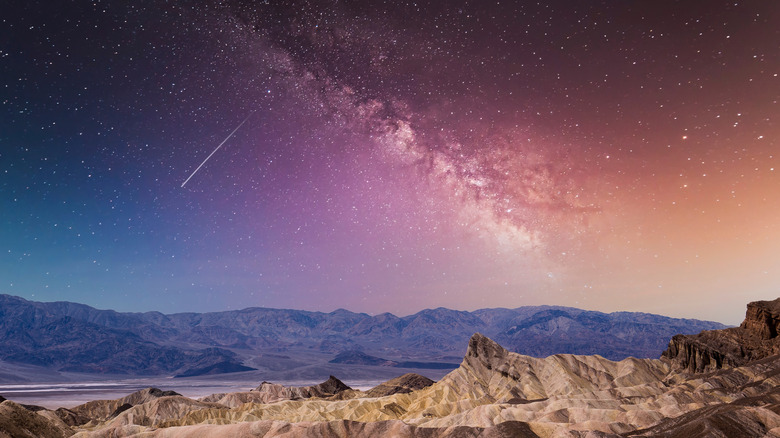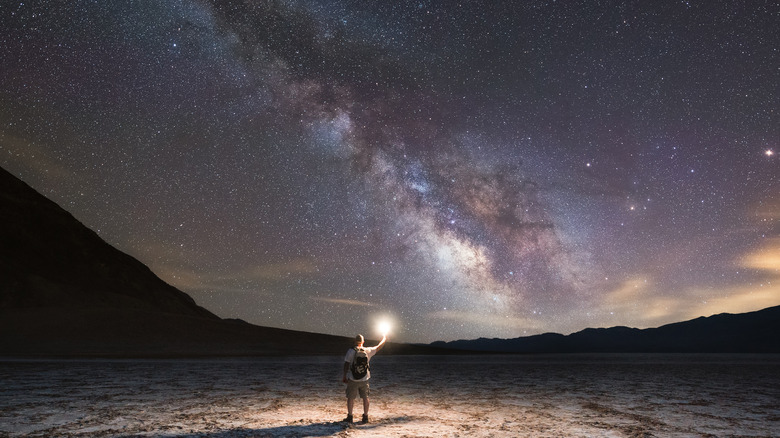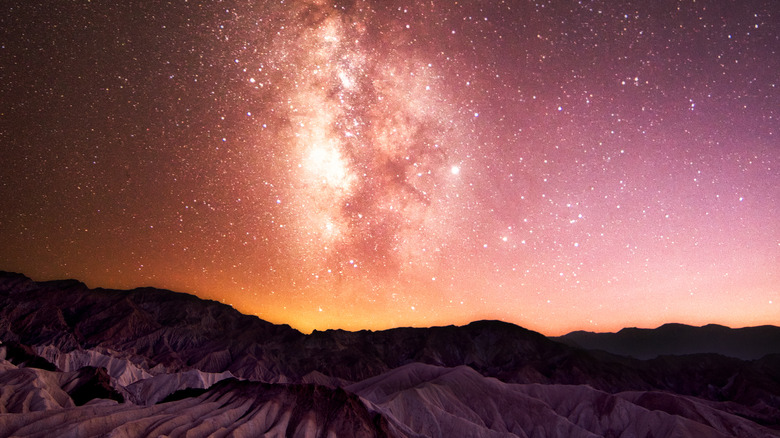The Best Time To View The Milky Way In Death Valley National Park
Death Valley National Park in California is located more than 100 miles from any major city, the closest being Las Vegas, according to TravelMath. Because of this, Death Valley has minimal light pollution, which means it's dark enough at night to see the stars in the sky. In fact, the International Dark-Sky Association designated the park as Gold Tier level (the highest classification) because of its dark, dark nights. As a result, you'll be able to see many astronomical marvels here that you won't be able to view elsewhere, per the National Park Service (NPS), including the Milky Way.
At 3.4 million acres, Death Valley National Park is the largest dark-sky preserve in the U.S.A., according to Capture the Atlas. The park is open year-round, but most visitors come during the spring, per NPS. March to early May is the optimal time for Milky Way viewing because of the Earth's position as it revolves around the sun (per The Discoveries Of) and because of rising temperatures after this period (per Capture the Atlas). The Discoveries Of recommends checking a lunar calendar and scheduling your astronomical foray during a new moon so there's no light from the moon to block your view of the stars.
The Death Valley Dark Sky Festival
Spring at Death Valley is also when the park celebrates its annual Dark Sky Festival, which features many astronomy-related activities. There's stargazing, of course, as well as the Furnace Creek Star Party and constellation tours by park rangers, per the National Park Service (NPS). You can also do astronomy walks, listen to astronomy lectures, and join a night sky or astrophotography meetup or workshop, according to Travel Nevada.
Event partners include NASA's Goddard Space Flight Center, the Jet Propulsion Laboratory at California Institute of Technology, and the Ames Research Center, as well as the SETI Institute and the non-profit Death Valley Natural History Association. Regarding the festival, superintendent Mike Reynolds had this to say (via Pahrump Valley Times): "Visitors to the park are often amazed by the amount of stars they can see here. Some people have never seen the Milky Way before visiting Death Valley." If you're staying at the resort, Oasis at Death Valley, you can also join the Las Vegas Astronomical Society for night sky observations.
Best Death Valley areas to see the Milky Way
The National Park Service (NPS) advises finding a location that's at a distance from major roads, campgrounds, and lodging areas, but for the best star-viewing experience, head out to the Mesquite Flat Sand Dunes, Ubehebe Crater, Badwater Basin, or Harmony Borax Works. Despite being near a road, the Mesquite Flat Sand Dunes is still a great stargazing spot. "Make sure you go far enough in to avoid the lights from the cars. Or your eyes would have to readjust [every time]," advises a TripAdvisor reviewer. Once you're away from the road and car lights, find a tall sand dune and make yourself comfortable, suggests Night Sky Nerd. If a view from up top is not to your liking, head to Badwater Basin instead. "The juxtaposition standing at [282 feet] below sea level, yet being able to see the Milky Way because of the lack of artificial light was spectacular," a TripAdvisor reviewer gushed, adding, "... [G]oing on a clear night felt special."
Meanwhile, the Harmony Borax Works is a must-see at night, according to another TripAdvisor reviewer, as there are no lights in the old mine so you'll easily find the Milky Way. Plus, there are no mountains to block your view of the stars (per Night Sky Nerd). But, if you really want to see the Milky Way from an excellent spot with no light pollution, go to the Ubehebe Crater. "Depending on the time of year, you can see the whole sky lit up and glowing," a TripAdvisor reviewer wrote.


